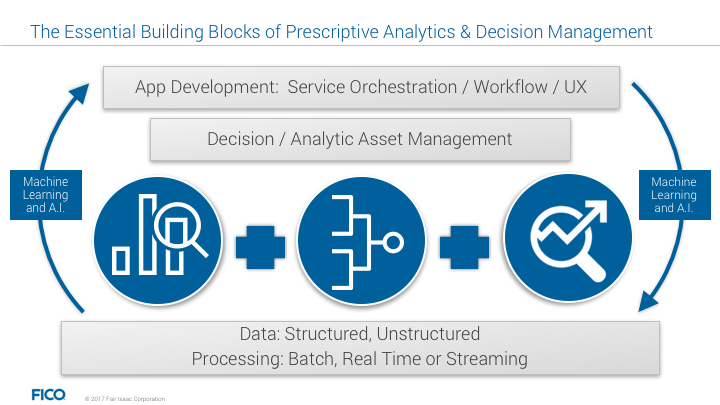The Secret Ingredients of Centralized Decisions
Blog: Enterprise Decision Management Blog

Prescriptive analytics, as the name suggests, is an output or a service that delivers a customized “what should I offer” response to real-time data and predictions on user or customer behavior. Unlike predictive analytics, which suggest what a customer is likely to do (or not do) based on data, prescriptive analytics takes that prediction and maps it to a business process. Instead of suggesting a customer may be inclined to buy something, a prescriptive model suggests the offer, the price, and, if implemented as part of a larger decision management strategy, delivers that offer in real time via the preferred channel (a web offer, email, via a mobile app, or through a call center or retail kiosk).
While it’s clear that prescriptive analytics is a super-powered predictive analytic, it often chafes the purist data scientist because it’s not really a pure analytic but rather a blend of several things (including analytics). So, the question I am constantly striving to answer is:
What makes an analytic solution truly prescriptive and how does an enterprise implement it in a powerful and automated fashion?
FICO has developed a proven, prescriptive analytic methodology that underpins our extensive enterprise software portfolio; it is a combination of predictive data sources and predictive analytic algorithms that can predict a customer’s most likely behavior, mapped to a strategic decision model that includes the business process, parameters, and operational data used to make any offer or treatment.
In other words, if you know that a customer is likely to do something you map that to a set of codified business logic that articulates how much inventory you have, what your risk tolerances are, what you know about customers in a particular segment, etc. This will generate a series of possible offers. Then you add an optimization algorithm to sift and sort those offers based on availability, revenue, margin, competitive takeout or any series of business factors to cull all the possible offers into the best offer.
Now this process happens almost instantaneously and, if done efficiently, appears almost magical to the customer. Just as importantly, that entire process is adjusted for point in time business priorities, inventory, and risk tolerances. It is entirely automated, yet documented. It can be tracked and measured. And, perhaps most importantly, it can self-learn using machine learning or AI techniques. To the customer it represents a consistent and optimal engagement that should be delightful and engaging.
A Fundamental Shift in Enterprise-Wide Prescriptive Analytics
For business, this process represents a fundamental sea change in customer engagements. However, dear reader, you will do yourself a disservice if you only think about marketing or sales engagements. This same process can be used across a very diverse set of business engagements, including new customer on-boarding or loyalty programs, detecting and mitigating fraud throughout your business, inventory or supply chain management, pricing and packaging, and frankly across virtually every business process application.
Now, here is where things get interesting. Early this year customers started asking for help in connecting different business decisions. First it was new customer on-boarding and fraud or marketing and fraud. These “connected decision” areas made sense. Connecting loyalty program applications with a fraud treatment is logical. By connecting these decision solutions, FICO’s platform provided more than just a single view of the customer, it delivered a view of the customer lifecycle across multiple lines of business.
Connecting decisions appeared to be the next logical evolution of how customers would use our solutions. However, we have been surprised by the number of customers asking to go all the way to the last logical step and skip the intermediate connected decisions all together.
Instead of connecting one analytic powered decision solution to another, our customers are asking us to plan out a full, enterprise-wide, centralized decision solution that will automatically power all lines of business and deliver, for the first time ever, a complete business-wide, 360-degree view of the customer across the entire customer lifecycle. This is no longer evolutionary but rather revolutionary in scale and scope.
We will endeavor to report on how these customer engagements progress and scale. However, it’s heartening to see that the journey we began in 2013 to build a robust decision management and prescriptive analytics platform and authoring suite coming to its logical conclusion in truly transforming a wide range of enterprises into autonomic, data driven, adaptive (and consistent) organizations.
We are kicking off a series of webinars over the next few months (starting with our first on December 12, 2017) covering the concepts of prescriptive analytics, connected decisions, and centralized decisioning solutions. We hope you will join us for one or more of these webinars. In addition, we have a number of downloads — executive briefs, white papers, or customer stories — that cover these conceptually or practically that we hope you will find useful and informative.
To continue this conversation, follow me on Twitter @baerjamin.
The post The Secret Ingredients of Centralized Decisions appeared first on FICO.
Leave a Comment
You must be logged in to post a comment.








